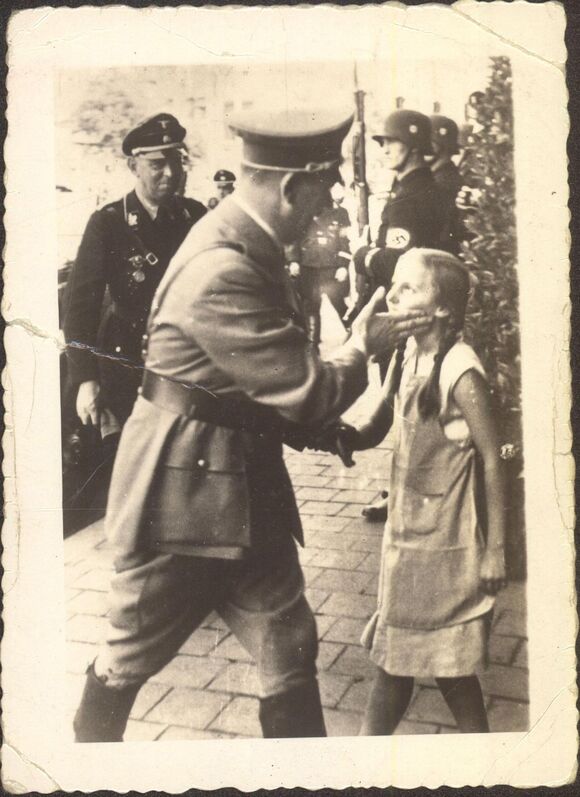- Producer:
Photo-Harren, Nuremberg
- Date:
ca. 1934, during a Nazi Party Rally
- Material:
Original print on photographic paper
- Dimensions:
7 cm x 9.5 cm (2¾ x 3¾ in.)
- Description:
Contemporary photographic print with wavy edge, stamped "Photo Harren Nürnberg Färberstrasse und Allersbergerstrasse" on the back
- Collection No.:
DZ-Ph 1306-01
A small photo donated to the Documentation Center in 2020 shows Adolf Hitler on his way into the Deutscher Hof hotel. Guards from his personal military bodyguard, the Leibstandarte, can be seen in the background. He appears to be affectionately stroking the face of a waiting girl. The subject matter exemplifies an iconic image – distributed by Heinrich Hoffmann's media firm, among others – that played a significant role in defining the visual propaganda of National Socialism.
Hitler, the Children's Friend – An iconic image by photographer Heinrich Hoffmann
Heinrich Hoffmann's first volume of photos of Adolf Hitler after the Nazi takeover in January 1933 was called Jugend um Hitler – "Young People around Hitler" – and was intended to demonstrate Hitler's special connection with "his" Volk by way of what was said to be his especially strong affection for children. Unusually for Nazi propaganda, which often focused on men and purported manliness, the photo book shows at least as many girls as boys, all of them conforming to the National Socialists' racist ideal. Indicatively, the caption under one two-page spread reads, "Many German tribes … but one race." (Later editions would change this to "Many German tribes … but one young generation.")
The numerous photos of Hitler with children were a way of compensating for the fact that Hitle – who was childless, officially had no relationship with a woman, and had supposedly forgone any private life to serve Germany alone – could not be portrayed as a paterfamilias at the head of the state. Hoffmann's media firm also produced a great many postcards showing Hitler with children, including Joseph Goebbels's children congratulating Hitler on his birthday and many similar scenes.
"Bernile" – Hitler and a girl with a Jewish grandmother
But one staged image got Heinrich Hoffmann's media company into trouble. It shows an especially close interaction between Hitler and a girl at the Berghof at Obersalzberg. The pictured child, Bernhardine Nienau (known as "Bernile"), had the same birthday as Hitler, April 20. She therefore met Hitler on that date and was "selected" to eat ice cream briefly with him. A subsequent correspondence, guided by her mother, was hoped to bring advantages to Bernile's family. The Jugend um Hitler photo album of 1934 gives prominent placement to the girl, with five full-page photos at the conclusion of the book. But as it later turned out, Bernhardine Nienau had a Jewish grandmother, so that the Bavarian Political Police, as well as Hitler's personal secretary Martin Bormann, ordered Hoffmann not to disseminate the story of Hitler and the little girl Bernile any further. Hoffmann complied only spottily, and at first even kept selling a new run of postcards showing Bernile. However, Bormann broke off any further contact between Hitler and the Nienau family. Hoffmann eventually followed suit. In later printings of Jugend um Hitler, Bernile had been replaced by other girls. The National Socialist propaganda about the Führer, who was supposed to be especially fond of children (as they were said to be of him), cared not one bit who the actual girl in the picture was. But of course she could never be a girl with a Jewish grandmother.
A Nuremberg imitation
The photo in the Documentation Center's collection does not come from Heinrich Hoffmann's media company, but from the Harren photography business in Fürth, which also had two shops in Nuremberg. This was an impromptu shot. The girl, Anneliese Haberrecker, lived at Sandstrasse 29, quite near the Deutscher Hof hotel. Apparently curious, like many people young and old at the time, she tried to catch a glimpse of the Führer. In front of the hotel, she succeeded: Hitler, an old hand at public gestures, caressed her face as he passed.
A photographer from the Harren business caught the moment and then displayed prints, numbered "33," for sale in the shops' show windows. Harren also produced a great many postcards of the Nazi Party Rallies – one of multiple small local competitors of Heinrich Hoffmann's conglomerate, which otherwise dominated the interregional media market. A co-worker of Anneliese's father alerted the family that a picture of her with Hitler was on display at one of the Harren company's shops. The father bought the photo, and thus it came into the photographed girl's possession. Many years later, in 2020, her brother donated the photo from his sister's estate to the Documentation Center at the Nazi Party Rally Grounds, and provided an account of the little picture's background.
Reference and for further reading:
Rudolf Herz: Hoffmann & Hitler. Fotografie als Medium des Führer-Mythos, München 1994, S. 248-252
Albert A. Feiber/ Hartmut Mehringer/ Horst Möller (Hg.): Die tödliche Utopie. Bilder, Texte, Dokumente, Daten zum Dritten Reich, Berlin 2010, S. 127 (Bernile, das 'deutsche Mädel')
The Documentation Center's collection includes another of Hoffmann's products:
A Flip Book from the 1929 Nazi Party Rally
Series "Brought to Light – from the collection of the Documentation Center"
Text and research: Alexander Schmidt
09.07.2020
Text license: CC BY SA 4.0
© Documentation Center Nazi Party Rally Grounds
Images may be used only with the prior consent of the Documentation Center Nazi Party Rally Grounds.
Contact form










